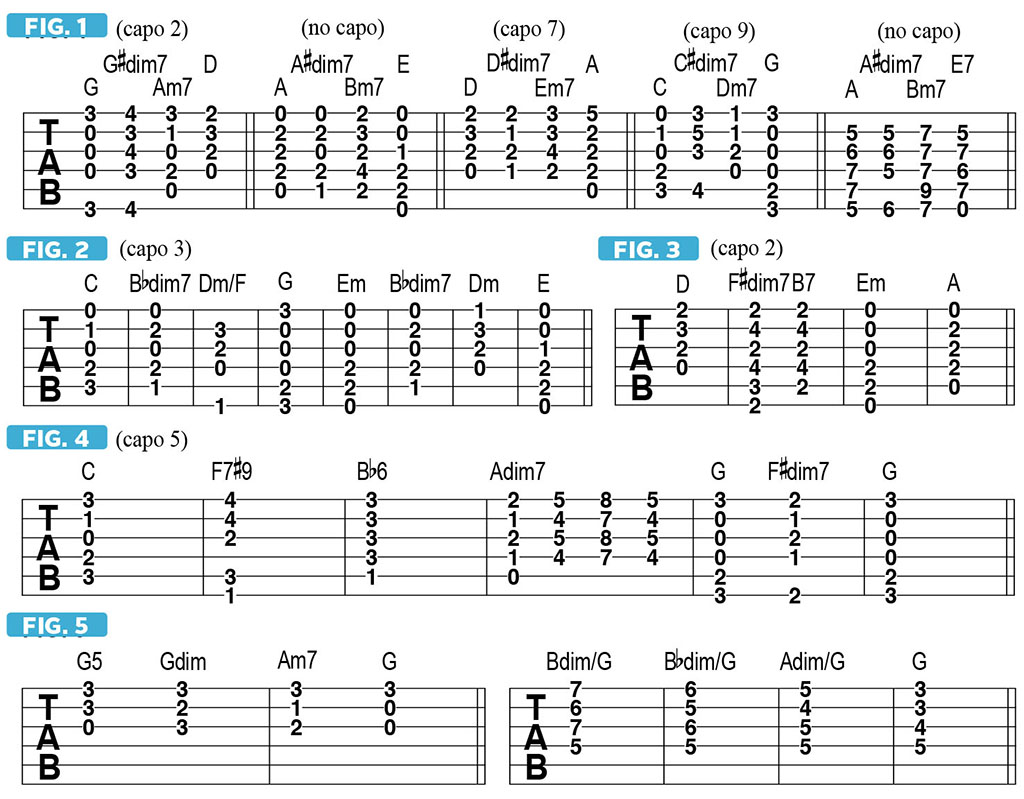How to Use the "Spooky" Dimished Seven Chord
Look at a few examples of fairly well-known songs from the modern era that utilize the dim7 chord in interesting, effective ways.
Last time, We checked out the “anxious”-sounding minor seven flat-five chord (m7b5), also known as half-diminished seven, which is spelled root, minor third, diminished fifth, minor seventh, or, more colloquially, among working musicians, “1 b3 b5 b7.” I’d now like to focus on that chord’s harmonic next-of-kin, so to speak, the fully diminished seven chord, or, simply, diminished seven (dim7), which is spelled, for all intents and purposes, root, minor third, diminished fifth, major sixth, or “1 b3 b5 6.” The dim7 chord has very unstable, “spooky” quality, and if held too long, it can sound “obnoxious,” as it absolutely needs to resolve to a more grounded major-or minor-type chord. As such, the dim7 chord was used often by classical composers between various major and minor chords to create a dramatic flow of harmonic tension and release, and it was also commonly used in popular songs written in the early to mid 20th century, many of which became jazz standards. What I’d like to do here is look at a few examples of fairly well-known songs from the modern era that utilize the dim7 chord in interesting, effective ways.
“Friends in Low Places,” famously sung by Garth Brooks, is a prime example of a pop-song usage of a dim7 chord, used as a transitional, or connecting, chord between the I major and ii minor chords in a major key. The song’s intro (and each verse) begins on A, followed by A#dim7 (A# C# E G), which then resolves satisfyingly to Bm7. These chords are performed on acoustic guitar with a capo at the second fret, using the finger-friendly and sonically pleasing “key of G” voicings illustrated in FIGURE 1, which also presents a few other ways to play the same basic changes in various areas of the neck, with and without a capo.
The chorus to “Adia” by Sarah McLachlan features a similar usage of a dim7 chord, specifically at 1:11, behind the lyric “we are still innocent,” and again a few bars later, at 1:24, behind “it’s easy, we all falter.” FIGURE 2 outlines the basic chord movement, played with a capo at the third fret, along the lines of what Sarah does.
Probably the most celebrated example of a dim7 chord in a pop song is the one former Beatle George Harrison played on acoustic guitar in “My Sweet Lord.” Using a capo at the second fret and performing the song as if it were in the key of D, the guitarist goes, at 0:26, from an open D chord to F#dim7, then B7, which takes him back to his recurring Em-to-A vamp. FIGURE 3 illustrates the basic voicing structure.

One interesting thing about the dim7 chord that is worth pointing out is that, due to its symmetrical interval structure — which consists of “stacked” minor thirds — you can move any voicing of it up or down the neck in three-fret increments and it will be the very same chord in a different inversion! Harrison demonstrated this beautifully with the harmonized electric slide guitar licks that he dubbed over the F#dim7 chord referenced above.
Paul McCartney also made great use of a dim7 chord in the Beatles’ “Michelle,” specifically at 0:14 and 0:17, behind the lyrics “these are words that go together well, my Michelle” as loosely sketched out in FIGURE 4. Again, notice the use of symmetrical inversions.
The intro to “Plush” by Stone Temple Pilots features an interesting and different kind of use of a diminished chord, in this case a diminished triad, Gdim (G Bb Db) over a Bb bass note (Gdim/Bb). FIGURE 5 outlines the simple three-note voicings guitarist Dean DeLeo plays, which are very effective and bring to mind the stock blues turnarounds popularized by Robert Johnson and other early blues guitarists. Note the use of the high G common tone here. The song “Come and Go Blues” by the Allman Brothers Band, which is also in the key of G, features a repeating verse progression that’s based on a similar kind of descending blues turnaround, as outlined in FIGURE 6.
Senior Music Editor "Downtown" Jimmy Brown is an experienced, working guitarist, performer and private teacher in the greater NYC area whose professional mission is to entertain, enlighten and inspire people with his guitar playing.
Get The Pick Newsletter
All the latest guitar news, interviews, lessons, reviews, deals and more, direct to your inbox!
Over the past 30 years, Jimmy Brown has built a reputation as one of the world's finest music educators, through his work as a transcriber and Senior Music Editor for Guitar World magazine and Lessons Editor for its sister publication, Guitar Player. In addition to these roles, Jimmy is also a busy working musician, performing regularly in the greater New York City area. Jimmy earned a Bachelor of Music degree in Jazz Studies and Performance and Music Management from William Paterson University in 1989. He is also an experienced private guitar teacher and an accomplished writer.










![Joe Bonamassa [left] wears a deep blue suit and polka-dotted shirt and plays his green refin Strat; the late Irish blues legend Rory Gallagher [right] screams and inflicts some punishment on his heavily worn number one Stratocaster.](https://cdn.mos.cms.futurecdn.net/cw28h7UBcTVfTLs7p7eiLe.jpg)

